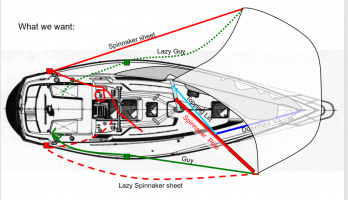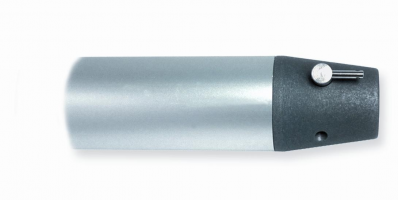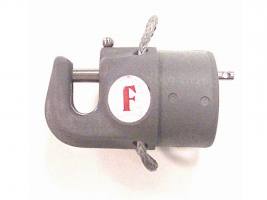I’m shopping for a whisker pole and seeking advice.
The “J” (forestay to mast at deck) distance on a 32-3/200 is 13.7 feet. I think this puts the ‘working distance’ on a telescoping pole for my boat somewhere between 12 feet and 16 feet depending on the sail employed.
Manufacturers
I’ve only found a handful of options:
Selden makes a whisker pole with discrete pin stops. You can order one here for just under $800. This is the largest of the poles that Selden makes (adjustable between 11 and 19.4 feet) and is suitable per Selden, for boats up to 20K lbs displacement @ half that of an E32. Another site listed the weight of the pole at 13 kilos, or 28.6 pounds. The pole has jaw fittings that would work on a line or a mast ring.
Forespar is the 800 lb gorilla of the space, it seems. They have a handy chart, arranged by manufacturer to help a buyer choose the right pole. For my boat, the recommended selection would be an LC 10-18 part number #401106. I’m pretty sure LC means “Line Control” or, continuously-adjustable length (vs. the discrete stops on the Selden) and 10-18’ refers to the length. The 10-18 size is recommended on Ericson 34’s also, and then bumps up to the next larger size (12-22) at the E35 level.
Part #401106 is all-aluminum, weighs approximately 17lbs and costs around $1100. I think the way to avoid shipping is to buy at my local West Marine and pick it up in-store.
Forespar also makes an all carbon telescoping pole. I did not find an all-carbon pole in 10-18 length, but the carbon 12-22 is part 800803 weighs 11lbs and costs $2170.
Finally, there is a hybrid aluminum/carbon pole (part 402203) with the aluminum external tube protecting the carbon. Fisheries Supply has the 12-22 version listed for $2340.
Forte
Defender carries Forte carbon fiber poles. They seem to be very close in price and manufacture to the equivalent Forespar poles.
Stowage
I have seen three common ways to store a pole.
1. On the deck. Forespar sells brackets that you can attach to your deck.
2. On the stanchions. This method gets the pole up off the deck and makes it less of a tripping hazard and more of a shin bruiser.
3. On the mast. This positions the pole on a track on the mast and +/- out of the way. One has to ensure that the pole to be stored is shorter than the distance between the deck and the steaming light. On my boat, this distance is about 13.8 feet. This solution involves the most infrastructure as one has to install a track up the mast and a car. It also puts weight aloft, which doesn’t make sense for boat dynamics. The T-Track is approximately $20 per foot, and a ring car is $160. So, call a track for a 13’ pole system $200 for track, $160 for the car, and $90 for a pole chock = $450 all in if a boat has none of these parts.
Given the various factors, I think at this point my best choice is to select the Forespar choice recommended off the chart (the 10-18’ all aluminum). I still don’t have a strong opinion on stowage though I like the idea of keeping the pole out of the way on the mast. I already have a ring car, so I just need to buy and install a longer track and a lower chock.
Opinions welcomed.
The “J” (forestay to mast at deck) distance on a 32-3/200 is 13.7 feet. I think this puts the ‘working distance’ on a telescoping pole for my boat somewhere between 12 feet and 16 feet depending on the sail employed.
Manufacturers
I’ve only found a handful of options:
Selden makes a whisker pole with discrete pin stops. You can order one here for just under $800. This is the largest of the poles that Selden makes (adjustable between 11 and 19.4 feet) and is suitable per Selden, for boats up to 20K lbs displacement @ half that of an E32. Another site listed the weight of the pole at 13 kilos, or 28.6 pounds. The pole has jaw fittings that would work on a line or a mast ring.
Forespar is the 800 lb gorilla of the space, it seems. They have a handy chart, arranged by manufacturer to help a buyer choose the right pole. For my boat, the recommended selection would be an LC 10-18 part number #401106. I’m pretty sure LC means “Line Control” or, continuously-adjustable length (vs. the discrete stops on the Selden) and 10-18’ refers to the length. The 10-18 size is recommended on Ericson 34’s also, and then bumps up to the next larger size (12-22) at the E35 level.
Part #401106 is all-aluminum, weighs approximately 17lbs and costs around $1100. I think the way to avoid shipping is to buy at my local West Marine and pick it up in-store.
Forespar also makes an all carbon telescoping pole. I did not find an all-carbon pole in 10-18 length, but the carbon 12-22 is part 800803 weighs 11lbs and costs $2170.
Finally, there is a hybrid aluminum/carbon pole (part 402203) with the aluminum external tube protecting the carbon. Fisheries Supply has the 12-22 version listed for $2340.
Forte
Defender carries Forte carbon fiber poles. They seem to be very close in price and manufacture to the equivalent Forespar poles.
Stowage
I have seen three common ways to store a pole.
1. On the deck. Forespar sells brackets that you can attach to your deck.
2. On the stanchions. This method gets the pole up off the deck and makes it less of a tripping hazard and more of a shin bruiser.
3. On the mast. This positions the pole on a track on the mast and +/- out of the way. One has to ensure that the pole to be stored is shorter than the distance between the deck and the steaming light. On my boat, this distance is about 13.8 feet. This solution involves the most infrastructure as one has to install a track up the mast and a car. It also puts weight aloft, which doesn’t make sense for boat dynamics. The T-Track is approximately $20 per foot, and a ring car is $160. So, call a track for a 13’ pole system $200 for track, $160 for the car, and $90 for a pole chock = $450 all in if a boat has none of these parts.
Given the various factors, I think at this point my best choice is to select the Forespar choice recommended off the chart (the 10-18’ all aluminum). I still don’t have a strong opinion on stowage though I like the idea of keeping the pole out of the way on the mast. I already have a ring car, so I just need to buy and install a longer track and a lower chock.
Opinions welcomed.




